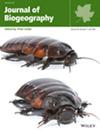β-Diversity Scaling Patterns Across Different Bioregionalisations for a Megadiverse Neotropical Fish Family
Abstract
Aim
Bioregionalisation frameworks represent unique assemblages of species resulting from geographic isolation and environmental heterogeneity. Understanding how different bioregionalisations capture community compositional variation is crucial, as underlying patterns and processes are scale-dependent. This study aimed to (1) explore the underlying ecological processes through the decomposition of beta diversity (turnover and nestedness); (2) identify which bioregionalisation framework offers the optimal spatial granularity for distinguishing between communities; and (3) evaluate the effective number of compositionally distinct areas.
Location
Neotropical domain.
Taxon
Rivulidae—annual species.
Methods
Presence–absence data of fish species were analysed using pairwise β-diversity and hierarchical clustering methods (UPGMA) and compared with 14 comprehensive bioregionalisation frameworks, including terrestrial ecoregions (TEOW), freshwater ecoregions (FEOW), neotropical provinces and watersheds (HydroBasins).
Results
The study revealed that (1) turnover is the dominant component of β-diversity, surpassing nestedness across all bioregionalisation frameworks; (2) turnover increases non-linearly as regionalisation area decreases, with a threshold identified beyond which further area reduction does not significantly increase turnover; and (3) the optimal spatial granularity for bioregionalisation is achieved at smaller watershed scales (146–414 km2), where turnover is maximised and the optimal number of bioregions (> 180) is identified.
Main Conclusions
Turnover patterns are linked to factors such as high endemism, low dispersal capacity and the significant isolation of temporary wetlands. The scale dependence of β-diversity is influenced not only by the area of bioregionalisations but also by the underlying design of these units, such as those based on hydrogeomorphological features (HydroBasins) or taxon distribution patterns (FEOW and TEOW). Finer spatial scales are more effective for assessing biodiversity patterns for endemic taxa and in habitats with low connectivity. These findings can enhance the understanding of how bioregionalisation frameworks reflect species compositional variation, with important implications for interpreting ecological patterns and developing scale-dependent conservation strategies.

 求助内容:
求助内容: 应助结果提醒方式:
应助结果提醒方式:


